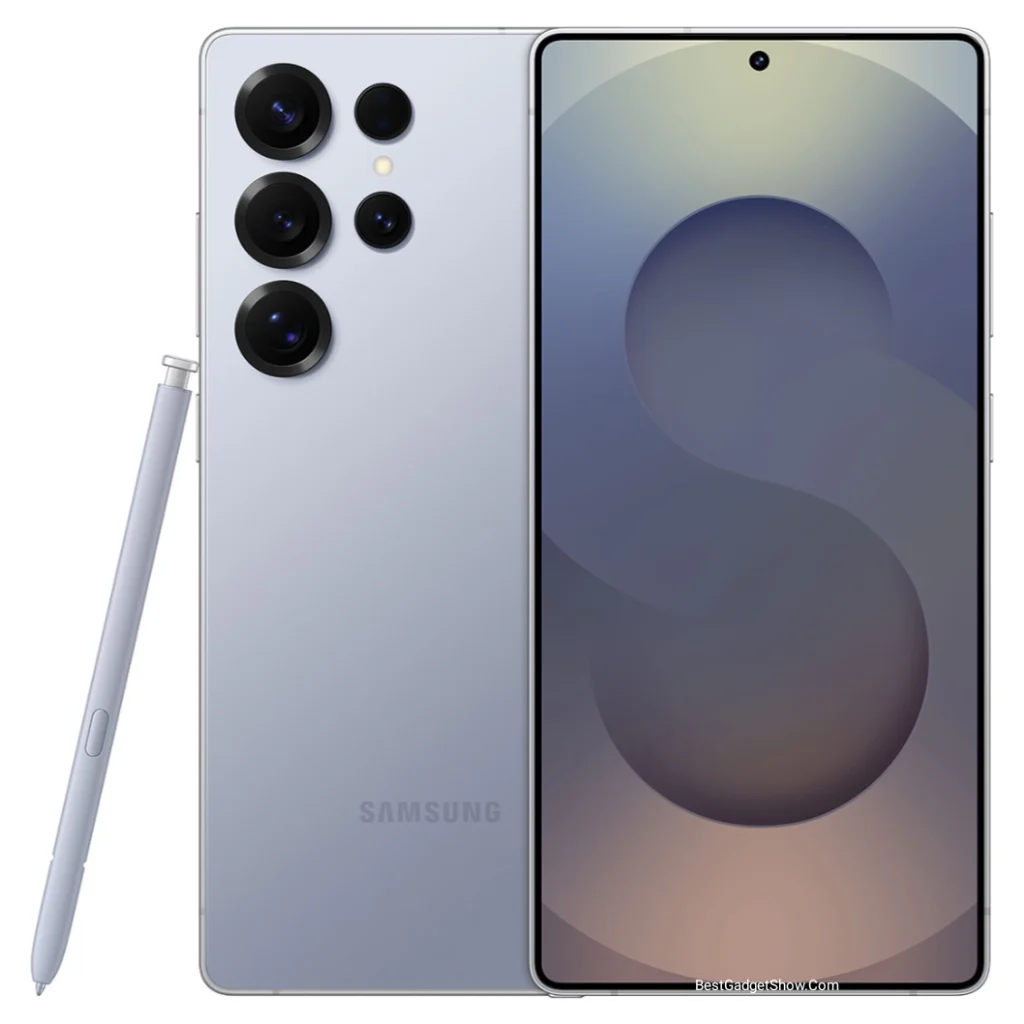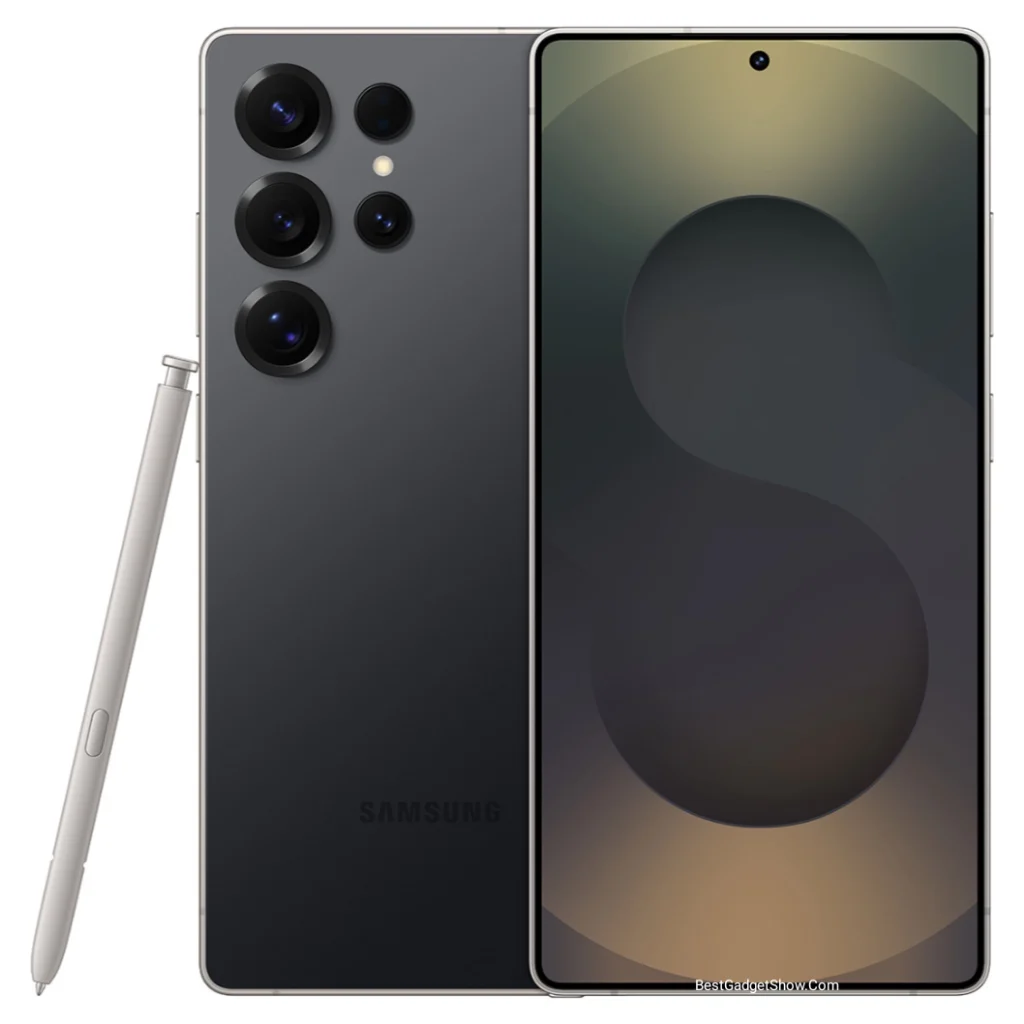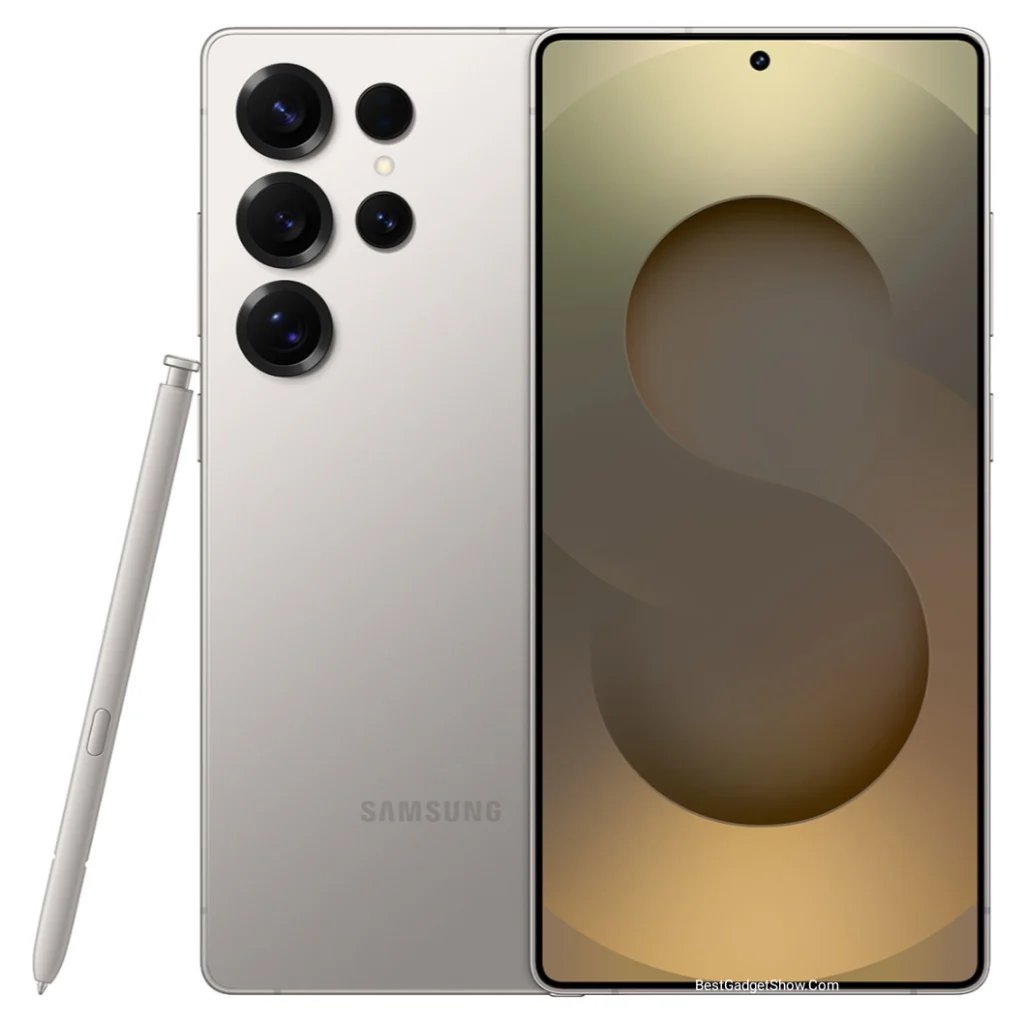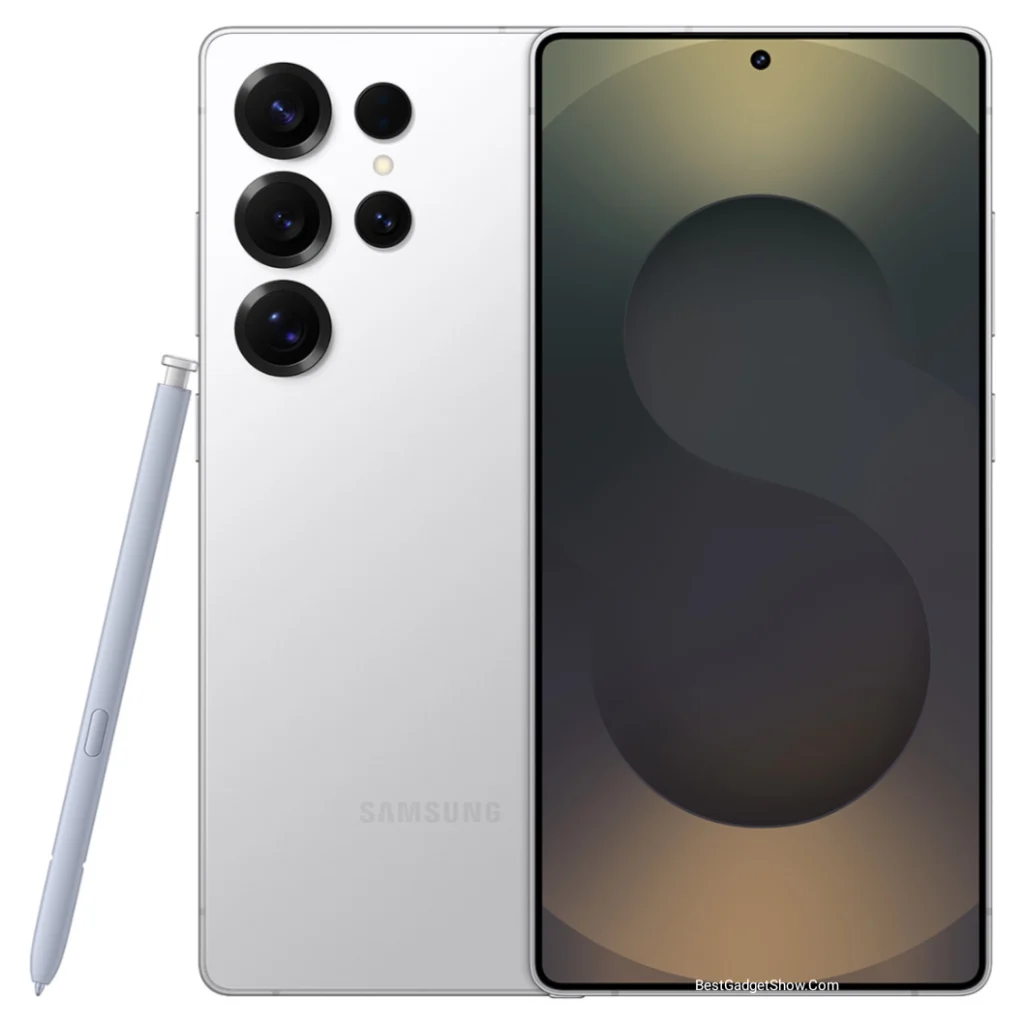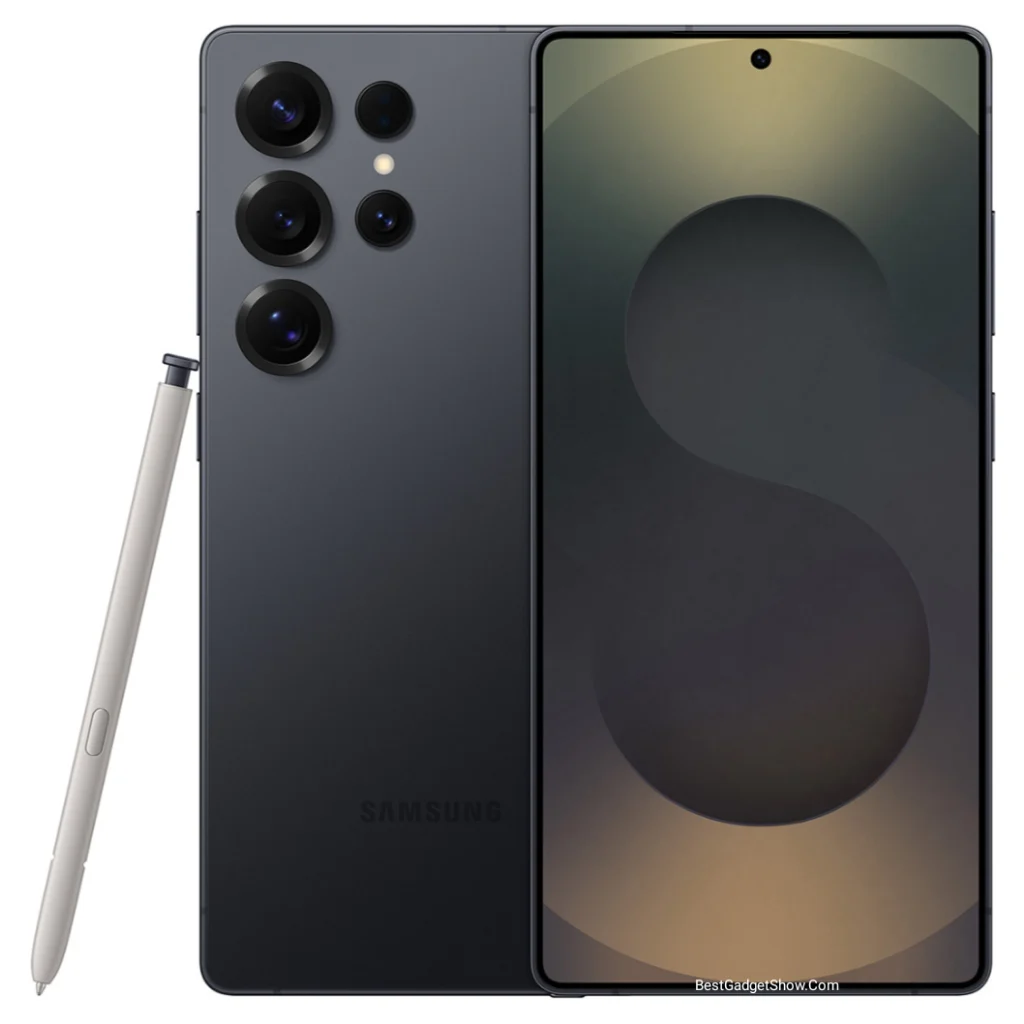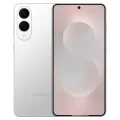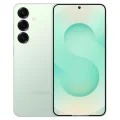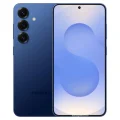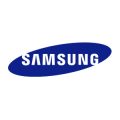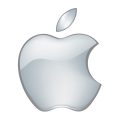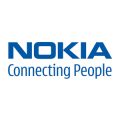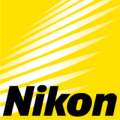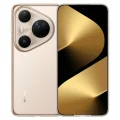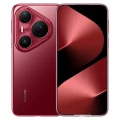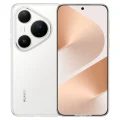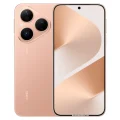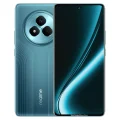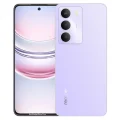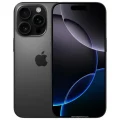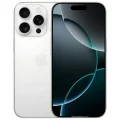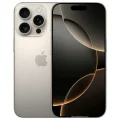- BestGadgetShow Home
- Smartphones
- Samsung Galaxy S25 Ultra
Samsung Galaxy S25 Ultra
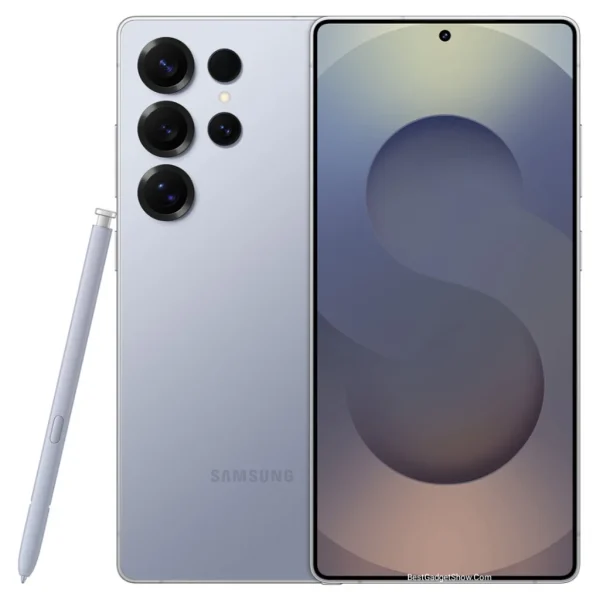

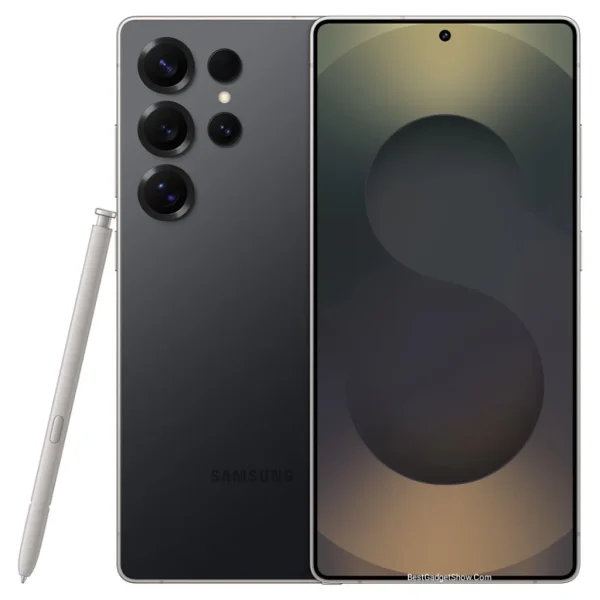
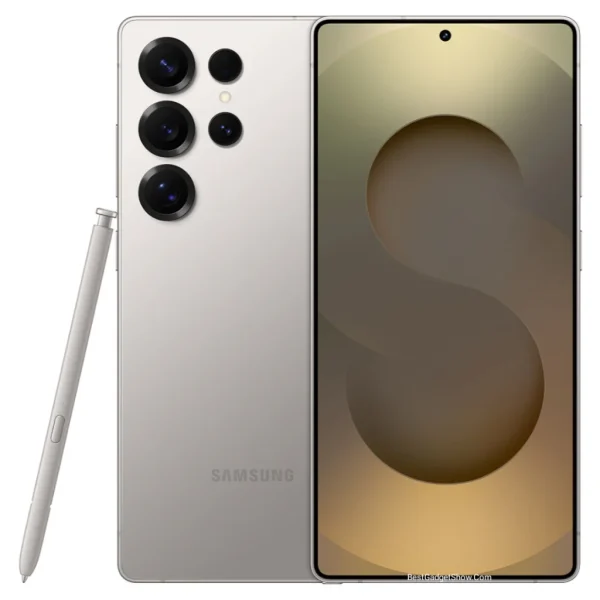
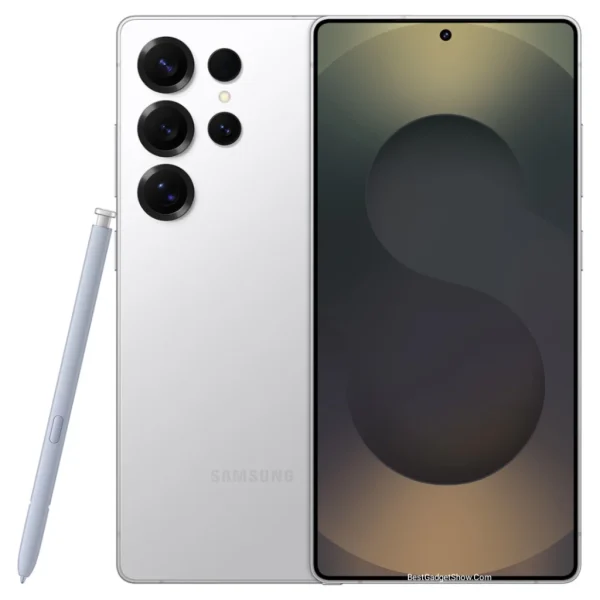
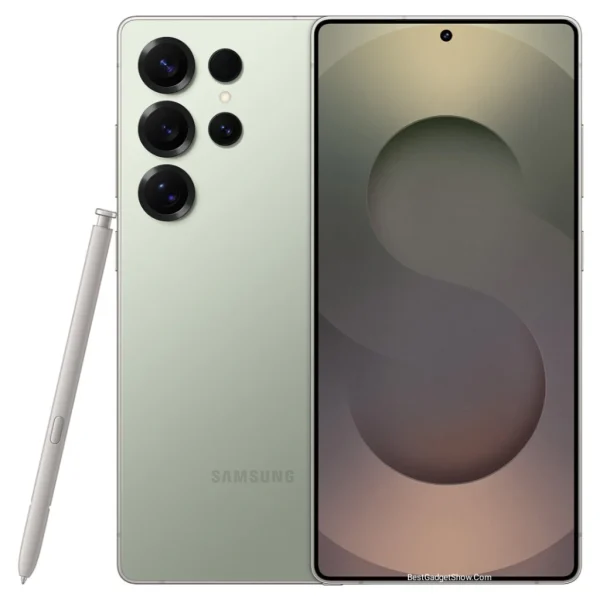
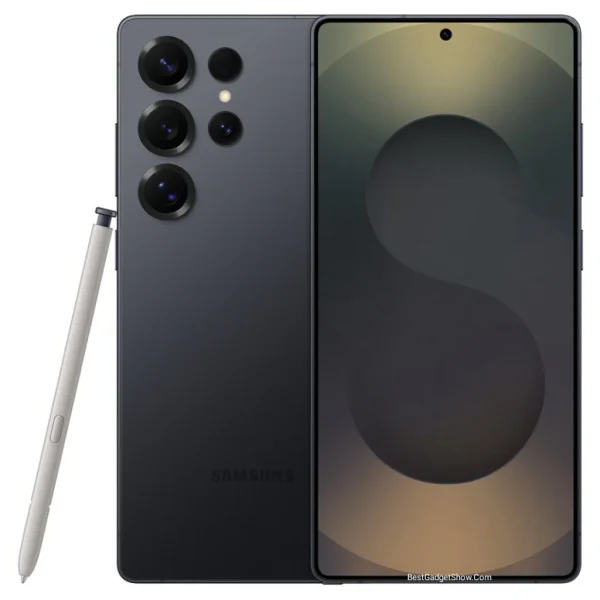
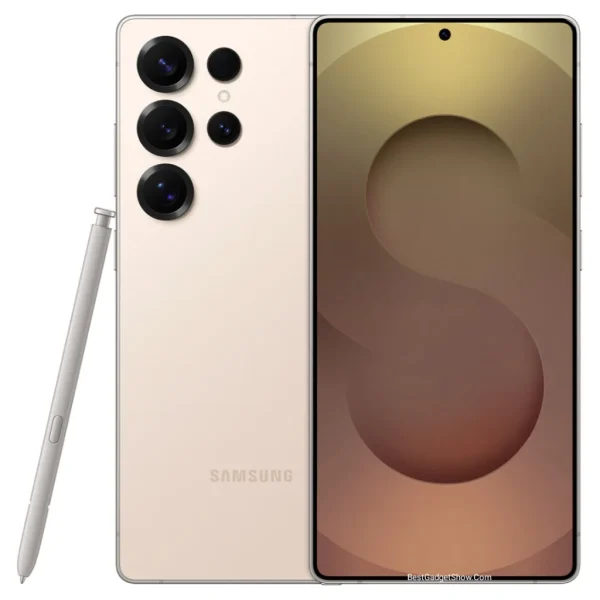
Specifications
NETWORK
| Technology Technology refers to the type of network standard or communication protocol a device uses to connect and operate. In mobile devices, technology includes generations like 2G, 3G, 4G, and 5G, which define data speed, coverage, and connectivity features. It also covers wireless technologies such as Wi-Fi, Bluetooth, NFC, and GPS. The choice of technology impacts device performance, compatibility with networks, and available features. Understanding the technology helps users know what kind of network support and capabilities to expect from a device, influencing its usability and future-proofing. | GSM / CDMA / HSPA / EVDO / LTE / 5G |
| 5G bands 5G bands are specific frequency ranges used to deliver 5G mobile connectivity. They are divided into low-band (below 1 GHz) for wide coverage, mid-band (1–6 GHz) for balanced speed and range, and high-band or mmWave (above 24 GHz) for ultra-fast speeds over short distances. Common bands include n78 (3.5 GHz), n41 (2.5 GHz), and n258 (26 GHz). Band support varies by region, carrier, and device, and plays a key role in determining 5G network performance and availability. |
1, 2, 3, 5, 7, 8, 12, 20, 25, 26, 28, 38, 40, 41, 66, 75, 77, 78 SA/NSA/Sub6 - International 1, 2, 5, 7, 25, 28, 41, 66, 71, 77, 78, 257, 258, 260, 261 SA/NSA/Sub6/mmWave - USA unlocked |
| 4G bands 4G bands refer to the specific frequency ranges used by LTE (Long Term Evolution) networks to deliver high-speed mobile data. These bands vary by region and carrier, with common ones including Band 1 (2100 MHz), Band 3 (1800 MHz), Band 7 (2600 MHz), Band 20 (800 MHz), and Band 28 (700 MHz). Devices must support the correct bands to work on a carrier's 4G network. LTE bands are divided into FDD (Frequency Division Duplex) and TDD (Time Division Duplex) types, affecting compatibility. Band support is crucial for roaming, signal strength, and network performance. |
1, 2, 3, 4, 5, 7, 8, 12, 13, 17, 18, 19, 20, 25, 26, 28, 32, 38, 39, 40, 41, 66 - International 1, 2, 3, 4, 5, 7, 8, 12, 13, 14, 18, 19, 20, 25, 26, 28, 29, 30, 38, 39, 40, 41, 48, 66, 71 - USA unlocked |
| 3G bands 3G bands are frequency ranges used by third-generation mobile networks, primarily based on UMTS/WCDMA technology, to provide faster data speeds and better voice quality compared to 2G. Common 3G bands include Band 1 (2100 MHz) widely used in Europe and Asia, Band 2 (1900 MHz) and Band 4 (1700/2100 MHz) in North America, and Band 5 (850 MHz) in the Americas and Asia. These bands enable mobile internet, video calls, and improved network capacity, but many are now being repurposed for 4G and 5G networks. |
HSDPA 850 / 900 / 1700(AWS) / 1900 / 2100 CDMA2000 1xEV-DO |
| 2G bands 2G bands are frequency ranges used by second-generation (2G) mobile networks, primarily for voice calls and basic data services like SMS and GPRS. The most common 2G technologies include GSM and CDMA, with GSM operating on bands such as 850 MHz, 900 MHz, 1800 MHz, and 1900 MHz. These bands vary by region—GSM 900/1800 in Europe, Asia, and Africa; GSM 850/1900 in the Americas. While once widespread, 2G is being phased out globally to make room for newer technologies like 4G and 5G. |
GSM 850 / 900 / 1800 / 1900 CDMA 800 / 1900 & TD-SCDMA |
| Speed Network speed refers to the rate at which data is transmitted between a device and the internet or cellular network. It affects how quickly you can browse websites, stream videos, download files, and make video calls. Network speed depends on the technology used, such as 2G, 3G, 4G, or 5G, with newer generations offering faster speeds and lower latency. Factors like signal strength, network congestion, and device capabilities also influence actual speeds. Higher network speeds enhance user experience by enabling smoother, more reliable connectivity for various online activities. | HSPA, LTE (up to 7CA), 5G |
| GPRS GPRS (General Packet Radio Service) is a 2G mobile data technology that enables basic internet services on mobile devices. It allows for packet-switched data transfer, making activities like web browsing, email, and MMS (Multimedia Messaging Service) possible at low speeds. GPRS marked a significant step forward from circuit-switched data by allowing multiple users to share the same transmission channels efficiently. While much slower than modern 3G, 4G, or 5G networks, GPRS provided early mobile internet access and remains a fallback option in areas with limited network coverage. | |
| EDGE EDGE (Enhanced Data rates for GSM Evolution) is a 2.5G mobile network technology that improves data transmission speeds over traditional GSM networks. It provides faster internet access, allowing basic web browsing, email, and multimedia messaging on mobile devices. While slower than 3G, 4G, and 5G, EDGE offers better coverage and connectivity in areas where newer networks are unavailable. It serves as an important fallback option for mobile users, especially in rural or remote locations, ensuring continuous data service when faster networks are out of reach. |
PRICES
| Global price Global price refers to the estimated or average cost of a product, such as a mobile phone or electronic device, across international markets. It serves as a general reference point, taking into account factors like production costs, global demand, and standard pricing strategies. However, actual prices may vary by country due to taxes, import duties, currency exchange rates, and local market conditions. Understanding the global price helps consumers and retailers compare affordability and value across different regions, especially when considering international purchases or product launches. | $858.90 / €941.90 / £859 / C$1,417 / ₹117,999 |
| United States In the United States, mobile phone prices vary widely depending on the brand, model, and features. Popular smartphones from brands like Apple, Samsung, and Google typically range from $300 for budget models to over $1,200 for the latest flagship devices. Prices can also fluctuate based on storage capacity, carrier deals, and whether the phone is purchased outright or through installment plans. Besides phones, other devices like tablets and smartwatches follow similar pricing trends, reflecting advances in technology and consumer demand. | $858.90 / $930 / $1,082.99 |
| Europe Mobile phone or any device price in Europe refers to the retail cost of electronic gadgets like smartphones, tablets, or laptops sold within European countries. Prices are influenced by factors such as VAT, import taxes, currency fluctuations, and local market competition. Additionally, different countries may have varying price points due to regional economic conditions and distribution costs. European consumers often benefit from promotions, carrier subsidies, or installment plans that affect the final price. Understanding device pricing in Europe helps buyers make informed decisions and compare costs across markets. | €941.90 / €1,040 / €1,289 |
| United Kingdom Mobile phone or any device price in the United Kingdom refers to the retail cost of smartphones, tablets, or other electronics within the UK market. Prices are influenced by factors such as taxes (including VAT), import duties, currency exchange rates, and competition among brands and retailers. Prices can vary between online and physical stores and are often affected by promotions, sales events, and new product launches. Understanding device prices in the UK helps consumers make informed purchasing decisions based on their budget, preferences, and available deals within the local market. | £859 / £1,349 / £1,207.49 |
| Canada Mobile phone or any device price in Canada refers to the retail cost of smartphones, tablets, or other electronic devices within the Canadian market. Prices can vary based on brand, model, specifications, and retailer. Factors like taxes, import duties, and currency exchange rates also influence the final cost. Canadian carriers often offer devices bundled with service plans, affecting overall affordability. Prices may differ between physical stores and online platforms, with frequent promotions or discounts available. Understanding device pricing helps consumers make informed purchasing decisions based on budget and desired features. | C$1,417 / C$1,527 |
| India Mobile phone or any device price in India refers to the retail cost of smartphones, tablets, or other electronics within the Indian market. Prices are influenced by factors such as import duties, local taxes (like GST), currency exchange rates, and competition among brands. Additionally, prices may vary between online and offline retailers, with frequent discounts and offers available during sales. Regional demand and manufacturing costs also affect pricing. Understanding device prices in India helps consumers make informed decisions based on their budget and feature preferences while navigating diverse market options. | ₹117,999 / ₹129,999 / ₹153,999 |
LAUNCHED
| Announced Mobile phone announced date refers to the official date when a phone manufacturer publicly reveals a new mobile device. This announcement usually includes key features, specifications, and release plans. It often occurs at events, press releases, or online launches, marking the start of the phone’s marketing and sales cycle before it becomes available to consumers. | 22 January, 2025 |
| Status Product availability status indicates whether a device or item is currently in stock and ready for purchase. Common statuses include "In Stock," meaning the product is available immediately; "Out of Stock," indicating temporary unavailability; and "Pre-order," where the product can be reserved before official release. Availability can vary by region, retailer, and demand. Knowing the product availability status helps consumers plan their purchases, avoid delays, and decide whether to wait for restocking or consider alternative options. It is a key factor in the buying process, especially for new or popular devices. | Available |
| Released Released refers to the official date when a device or product becomes available for purchase or public use. It marks the launch of the device in the market, often accompanied by announcements, marketing campaigns, and distribution to retailers. The release date helps consumers know when they can buy the product and allows comparison with other models or technologies available at the same time. Release timing can impact pricing, availability, and competition, making it an important factor for buyers and industry watchers alike. | 03 February, 2025 |
BODY
| Dimensions Dimensions refer to the physical measurements of a device, typically including its height, width, and thickness (depth). These measurements determine the size and shape of the device, affecting its portability, ergonomics, and how it fits in pockets, bags, or hands. Compact dimensions are often preferred for ease of use and mobility, while larger sizes may offer bigger screens or batteries. Knowing a device’s dimensions helps consumers understand its physical footprint and compare it with other models to find the best fit for their lifestyle and preferences. | 162.8 x 77.6 x 8.2 mm (6.41 x 3.06 x 0.32 in) |
| Weight Weight refers to the measure of how heavy an object is, usually expressed in units like grams, kilograms, pounds, or ounces. It indicates the force exerted on the object due to gravity. In products such as electronics, furniture, or packaging, weight is an important factor affecting portability, usability, and shipping costs. A lighter weight often means easier handling and transport, while heavier items may suggest durability or sturdiness. Understanding weight helps consumers make informed choices based on their needs and preferences. | 218 g (7.69 oz) |
| Build Mobile phone or any device build refers to the physical design, materials, and construction quality of a device. It includes the choice of materials like metal, glass, or plastic, the durability, weight, and ergonomics. A well-built device feels solid, fits comfortably in hand, and can withstand daily wear and tear. The build also affects features such as water and dust resistance (IP ratings) and impacts the overall user experience and device longevity. Manufacturers balance aesthetics, functionality, and durability when designing the build of mobile phones and other devices. | Glass front (Corning Gorilla Armor 2), glass back (Gorilla Glass Victus 2), titanium frame (grade 5) |
| SIM A SIM (Subscriber Identity Module) is a small card inserted into mobile devices that stores user identity and network information. It enables the device to connect to a cellular network, allowing phone calls, text messaging, and mobile data services. SIM cards contain unique identification numbers and security keys that authenticate the user on the network. They come in different sizes—standard, micro, and nano—to fit various devices. SIM cards also allow users to switch phones easily by transferring their mobile number and service to a new device. |
Nano-SIM + Nano-SIM + eSIM + eSIM (max 2 at a time) - INT Nano-SIM + eSIM + eSIM (max 2 at a time) - USA Nano-SIM + Nano-SIM - CN |
| Others Others refers to additional features, accessories, or specifications of a device that don’t fit into the main categories like display, battery, or processor. This section may include unique functionalities, special sensors, extra ports, bundled apps, or software enhancements. It can also cover miscellaneous details like certifications, design elements, or support for specific technologies. The “Others” category helps provide a complete overview of the device, highlighting extras that contribute to its overall value and user experience beyond standard specifications. |
IP68 dust tight and water resistant (immersible up to 1.5m for 30 min) Stylus |
DISPLAY
| Type Type refers to the classification or category of a device based on its design, functionality, or intended use. For example, mobile devices can be smartphones, feature phones, tablets, or wearables. In technology, type can also describe hardware components such as display type (LCD, OLED), battery type (Li-ion, Li-Po), or network type (GSM, CDMA). Knowing the type helps users understand the device’s capabilities, compatibility, and suitability for their needs. It provides a clear overview of what kind of product or technology is being described or used. | Dynamic LTPO AMOLED 2X, 120Hz, 480Hz PWM, HDR10+, 2600 nits (peak) |
| Size Display size refers to the diagonal measurement of a device’s screen, typically expressed in inches. It determines how large the visible area is for viewing content like videos, apps, and games. Larger display sizes offer more immersive experiences and easier readability but can affect the device’s overall size and portability. Smaller screens are more compact and easier to handle with one hand. Display size is an important factor when choosing devices, balancing usability, comfort, and multimedia enjoyment based on personal preferences and usage needs. | 6.9 inches, 116.9 cm2 (~92.5% screen-to-body ratio) |
| Resolution Resolution refers to the number of pixels displayed on a screen, typically expressed as width × height (e.g., 1920×1080). It determines the sharpness and clarity of images, text, and videos on devices like smartphones, tablets, and monitors. Higher resolution means more pixels, resulting in finer details and smoother visuals. Common resolutions include HD, Full HD, and 4K. Resolution impacts display quality and user experience, especially for media consumption, gaming, and reading. However, higher resolution may also affect battery life and performance depending on the device’s hardware capabilities. | 1440 x 3120 pixels, 19.5:9 ratio (~498 ppi density) |
| Protection Protection refers to the features and technologies built into a device to safeguard it from damage, unauthorized access, and data loss. This includes physical protection like water and dust resistance (IP ratings), shockproof designs, and durable materials, as well as software security measures such as encryption, biometric locks (fingerprint or face recognition), and antivirus support. Protection ensures the device remains functional and secure in various environments, extending its lifespan and keeping user data safe from theft or accidental damage. Strong protection features enhance user confidence and device reliability. |
Corning Gorilla Armor 2 |
| Features Features refer to the specific functions, capabilities, and characteristics of a device, such as a mobile phone, tablet, or laptop. These can include hardware elements like camera quality, display type, battery life, and processor, as well as software capabilities such as operating system, security options, and connectivity (e.g., 5G, Wi-Fi, Bluetooth). Features help define the overall performance, usability, and value of a device. Consumers often compare features to determine which device best meets their needs for communication, entertainment, productivity, or gaming. The more advanced and user-friendly the features, the more appealing the device typically is. |
Dynamic AMOLED 2X display 120Hz adaptive refresh rate (for smooth scrolling) Peak brightness of 3200 nits Anti-reflective properties 16M Color Depth (Main Display) 6.8" rounded corners Display Aspect Ratio 19.5:9. S Pen Support High pixel density of around 498 ppi |
PLATFORM
| OS OS (Operating System) is the core software that manages a device’s hardware and software resources, providing a platform for applications to run. It controls essential functions like memory management, task scheduling, input/output operations, and user interface. Common mobile OS examples include Android and iOS, while computers often use Windows, macOS, or Linux. The OS enables users to interact with the device through graphical interfaces and ensures smooth operation by coordinating hardware and software components. A well-designed OS enhances usability, security, and performance of smartphones, tablets, laptops, and other electronic devices. | Android 15, up to 7 major Android upgrades, One UI 7 |
| Chipset A Chipset is a collection of integrated circuits on a device’s motherboard that manages communication between the processor, memory, storage, and peripherals. In mobile phones and computers, the chipset controls data flow and enables essential functions like processing, graphics rendering, and connectivity. It plays a critical role in overall device performance, power efficiency, and feature support. Different chipsets offer varying capabilities, affecting speed, camera quality, gaming, and network support. Popular mobile chipsets include those from Qualcomm Snapdragon, Apple A-series, and MediaTek. | Qualcomm SM8750-AB Snapdragon 8 Elite (3 nm) |
| CPU The CPU (Central Processing Unit) is the brain of a device, responsible for executing instructions and performing calculations that run applications and operating systems. It processes data, manages tasks, and controls other hardware components to ensure smooth operation. CPUs vary in speed, number of cores, and architecture, which influence a device’s overall performance and efficiency. In smartphones, laptops, and desktops, a powerful CPU enables faster multitasking, better gaming, and improved responsiveness. Modern CPUs often include integrated graphics and energy-saving features to balance performance with battery life. | Octa-core (2x4.47 GHz Oryon V2 Phoenix L + 6x3.53 GHz Oryon V2 Phoenix M) |
| GPU A GPU (Graphics Processing Unit) is a specialized processor designed to handle graphics rendering and visual computations in devices like smartphones, tablets, and computers. It works alongside the CPU to manage tasks such as gaming, video playback, image processing, and UI animations. Modern GPUs also support advanced features like 3D rendering, augmented reality, and AI acceleration. In mobile devices, the GPU is integrated into the chipset and plays a crucial role in delivering smooth visuals and an enhanced user experience. A powerful GPU results in better graphics performance and more efficient handling of visually demanding tasks. | Adreno 830 |
MEMORY
| Card Slot A Memory Card is a small, removable storage device used to expand the storage capacity of mobile phones, cameras, tablets, and other electronic devices. Common types include microSD and SD cards. A card slot is the physical port on a device where the memory card is inserted. It allows users to easily add or remove storage for saving photos, videos, apps, and files. Memory cards provide a convenient way to increase device storage without upgrading internal memory, and they enable easy data transfer between devices. | No |
| Internal Internal storage is the built-in space within a device used to save the operating system, applications, and user data such as photos, videos, and documents. Measured in gigabytes (GB) or terabytes (TB), it determines how much content the device can hold. Unlike external storage like memory cards, internal storage is fixed and not removable. Adequate internal storage ensures smooth device performance and allows users to install apps and store files without running out of space. Devices with larger internal storage provide more flexibility and convenience for everyday use. | 256 GB/512 GB / 1TB UFS 4.0 |
| RAM RAM (Random Access Memory) is a type of fast, temporary memory used by a device to store data that the processor needs quickly while running apps and performing tasks. More RAM allows smoother multitasking and better performance, enabling devices to handle multiple applications simultaneously without slowing down. In smartphones, computers, and tablets, RAM affects how responsive and efficient the device feels during use. Unlike storage memory, RAM is volatile, meaning it clears when the device is turned off. Adequate RAM is essential for seamless operation, especially with demanding software and games. | 12 GB, 16 GB |
| Variant A variant refers to a version or form of something that differs slightly from others within the same category. In products, variants might include different colors, sizes, features, or models designed to meet diverse customer preferences. For example, a smartphone may have multiple variants with varying storage capacities or camera setups. Variants help businesses offer personalized options while maintaining the core identity of the product or service. This concept is widely used in industries like technology, fashion, and manufacturing to cater to different market needs. | 12GB 256GB / 12GB 512GB / 12GB 1TB / 16GB 1TB |
MAIN CAMERA
| Quad A quad camera setup on a smartphone includes four separate lenses and sensors working together to enhance photography capabilities. Each camera typically serves a different purpose, such as a main sensor for high-resolution images, an ultra-wide lens for capturing broader scenes, a macro lens for close-up shots, and a depth sensor for improved portrait effects. This combination allows users to take versatile and high-quality photos in various conditions, offering better detail, depth, and creative options compared to single or dual cameras. Quad cameras are common in mid-range and flagship smartphones for advanced photography. |
200 MP, f/1.7, 24mm (wide), 1/1.3", 0.6µm, multi-directional PDAF, OIS 10 MP, f/2.4, 67mm (telephoto), 1/3.52", 1.12µm, PDAF, OIS, 3x optical zoom 50 MP, f/3.4, 111mm (periscope telephoto), 1/2.52", 0.7µm, PDAF, OIS, 5x optical zoom 50 MP, f/1.9, 120˚ (ultrawide), 1/2.5", 0.7µm, dual pixel PDAF, Super Steady video |
| Features Features refer to the specific functions, capabilities, and characteristics of a device, such as a mobile phone, tablet, or laptop. These can include hardware elements like camera quality, display type, battery life, and processor, as well as software capabilities such as operating system, security options, and connectivity (e.g., 5G, Wi-Fi, Bluetooth). Features help define the overall performance, usability, and value of a device. Consumers often compare features to determine which device best meets their needs for communication, entertainment, productivity, or gaming. The more advanced and user-friendly the features, the more appealing the device typically is. |
Laser AF, Best Face, LED flash, auto-HDR, panorama |
| Video Quality Video quality refers to the clarity, detail, and overall visual experience of a video. It is influenced by factors like resolution, frame rate, bitrate, and compression. Higher video quality means sharper images, smoother motion, and more accurate colors, enhancing the viewing experience. Common resolutions include 720p, 1080p (Full HD), and 4K, with higher resolutions offering greater detail. Video quality depends on the source, device capabilities, and internet speed during streaming, making it a key factor for content creators and viewers alike. | 8K@24/30fps, 4K@30/60/120fps, 1080p@30/60/120/240fps, 10-bit HDR, HDR10+, stereo sound rec., gyro-EIS |
SELFIE CAMERA
| Single A single camera setup on a smartphone or device features one main lens and sensor used for capturing photos and videos. Despite having just one camera, modern single-camera systems often include advanced technologies like AI enhancements, autofocus, and image stabilization to improve picture quality. Single cameras are common in budget and mid-range devices, offering simplicity and good performance for everyday photography. While they may lack the versatility of multiple-lens setups, single cameras can still capture sharp, clear images suitable for casual users. |
12 MP, f/2.2, 26mm (wide), 1/3.2", 1.12µm, dual pixel PDAF |
| Features Features refer to the specific functions, capabilities, and characteristics of a device, such as a mobile phone, tablet, or laptop. These can include hardware elements like camera quality, display type, battery life, and processor, as well as software capabilities such as operating system, security options, and connectivity (e.g., 5G, Wi-Fi, Bluetooth). Features help define the overall performance, usability, and value of a device. Consumers often compare features to determine which device best meets their needs for communication, entertainment, productivity, or gaming. The more advanced and user-friendly the features, the more appealing the device typically is. |
HDR, HDR10+ |
| Video Quality Video quality refers to the clarity, detail, and overall visual experience of a video. It is influenced by factors like resolution, frame rate, bitrate, and compression. Higher video quality means sharper images, smoother motion, and more accurate colors, enhancing the viewing experience. Common resolutions include 720p, 1080p (Full HD), and 4K, with higher resolutions offering greater detail. Video quality depends on the source, device capabilities, and internet speed during streaming, making it a key factor for content creators and viewers alike. | 4K@30/60fps, 1080p@30fps |
SOUND
| Alert Types Mobile phone alert types are the different ways a phone notifies you of incoming calls, messages, or notifications. Common types include ringtone (audible sound), vibration (silent physical alert), visual alerts (LED lights or screen flashes), and notification sounds for apps. Some phones also support custom alerts like patterns or tones, and emergency alerts for critical warnings. These options help users stay informed in various environments and personal preferences. | Vibration, MP3, WAV ringtones |
| Loudspeaker A loudspeaker is a device that converts electrical audio signals into sound, allowing users to hear music, calls, notifications, and other audio from a mobile phone, computer, or speaker system. In mobile phones, loudspeakers enable hands-free calling, media playback, and alerts without headphones. The quality of a loudspeaker affects sound clarity, volume, and bass response. Some devices feature multiple loudspeakers or stereo setups for enhanced audio experience. Loudspeakers are essential for immersive multimedia use and convenient communication in everyday device usage. | Yes, with stereo speakers |
| 3.5mm jack The 3.5mm jack is a widely used analog audio connector found on headphones, smartphones, laptops, and audio equipment. It supports mono, stereo, and microphone input through different pin configurations such as TS, TRS, and TRRS. Known for its simplicity and universal compatibility, it has been a standard for decades. However, many modern devices are phasing it out in favor of digital and wireless alternatives like USB-C, Lightning, and Bluetooth to save space and enhance waterproofing. Despite this, the 3.5mm jack remains popular for its reliability and low-latency audio performance. |
No 32-bit/384kHz audio Tuned by AKG |
CONNECTIVITY
| WLAN WLAN (Wireless Local Area Network) is a technology that allows devices to connect to the internet or communicate with each other wirelessly within a limited area, such as a home, office, or café. It uses radio waves instead of cables, enabling mobility and convenience. Commonly known as Wi-Fi, WLAN supports multiple devices like smartphones, laptops, and smart home gadgets. It provides flexible network access without physical connections, making it essential for modern wireless communication and internet use. | Wi-Fi 802.11 a/b/g/n/ac/6e/7, tri-band, Wi-Fi Direct |
| Bluetooth Bluetooth is a wireless communication technology that allows devices to connect and exchange data over short distances, usually up to 10 meters. It’s commonly used for pairing smartphones with wireless headphones, speakers, keyboards, and other peripherals. Bluetooth supports low power consumption and secure connections, making it ideal for everyday wireless communication. It enables features like hands-free calling, file sharing, and device syncing without the need for cables. Over time, Bluetooth has evolved to support faster speeds, longer range, and improved reliability, becoming a standard feature in most modern electronic devices. | 5.4, A2DP, LE |
| Positioning Positioning refers to the technology used by devices to determine their precise location using satellite navigation systems. Common systems include GPS (USA), GLONASS (Russia), BDS (China), GALILEO (Europe), and QZSS (Japan). Devices equipped with multiple systems improve accuracy, reliability, and coverage worldwide by accessing more satellites simultaneously. This enables precise navigation, mapping, location-based services, and tracking, essential for smartphones, vehicles, and outdoor activities. Combining these global and regional systems ensures better performance in diverse environments, including urban areas and remote locations. | GPS, GLONASS, BDS, GALILEO, QZSS |
| NFC NFC (Near Field Communication) is a short-range wireless technology that enables devices to communicate when placed close together, typically within a few centimeters. It’s commonly used for contactless payments, data sharing, and quick device pairing. NFC is fast, secure, and easy to use, allowing smartphones, smartwatches, and other gadgets to exchange information without physical connections. Popular applications include mobile wallets like Apple Pay and Google Pay, access control, and public transport ticketing. NFC technology enhances convenience and supports seamless interactions in everyday digital life. | Yes |
| FM Radio FM Radio on a mobile device allows users to listen to live, over-the-air radio broadcasts using frequency modulation (FM). It typically requires wired headphones to act as an antenna. FM radio provides access to local music, news, and talk shows without using mobile data or Wi-Fi. This feature is especially useful in areas with limited internet connectivity or during emergencies. While many modern smartphones no longer include it, FM radio remains a valuable feature in budget and mid-range phones, offering entertainment and information without additional costs. | No |
| USB USB (Universal Serial Bus) is a widely used standard for connecting devices to computers and other electronics. It allows for data transfer and power supply between devices like keyboards, mice, flash drives, printers, and smartphones. USB has evolved through various versions, including USB 2.0, 3.0, and USB-C, each offering faster speeds and improved functionality. Its plug-and-play design makes it easy to use, and it supports a broad range of devices, making it an essential and versatile technology in modern computing and electronics. | USB Type-C 3.2, DisplayPort 1.2, OTG |
| Infrared port An infrared (IR) port is a communication interface on some devices that uses infrared light to wirelessly transmit data over short distances. Commonly found in older mobile phones and remote controls, it allows devices to exchange information like contacts, files, or control signals without cables. IR ports require a direct line of sight between devices and have limited range, typically a few centimeters to a meter. Although largely replaced by Bluetooth and Wi-Fi, infrared ports are still used in certain applications like TV remotes and some smart home devices for simple, reliable communication. |
FEATURES
| Sensors Sensors are hardware components in devices that detect and measure physical properties like motion, orientation, light, and proximity. Common sensors in smartphones include accelerometers, gyroscopes, proximity sensors, ambient light sensors, and fingerprint scanners. These sensors enable features such as screen rotation, step tracking, automatic brightness adjustment, face recognition, and gesture control. By collecting real-time data from the environment, sensors enhance device functionality, improve user experience, and support various applications in gaming, health, navigation, and security. |
Fingerprint (under display, ultrasonic), accelerometer, gyro, proximity, compass, barometer Samsung DeX, Samsung Wireless DeX (desktop experience support) Ultra Wideband (UWB) support Circle to Search |
| Messaging Messaging refers to the ability of a device to send and receive text-based communication, including SMS (Short Message Service), MMS (Multimedia Messaging Service), and instant messages through apps. It allows users to exchange information quickly using text, images, videos, and audio. Messaging is a fundamental feature in mobile phones and other devices, supporting personal and business communication. Modern messaging also includes group chats, emojis, and multimedia sharing, enhancing interaction and connectivity. Secure messaging apps further offer encrypted communication to protect privacy and data. | SMS (threaded view), MMS, Email, Push Email, IM |
| Browser A browser is a software application that allows users to access, navigate, and view content on the internet. It interprets and displays web pages, including text, images, videos, and interactive elements, by communicating with web servers using protocols like HTTP or HTTPS. Popular browsers include Google Chrome, Mozilla Firefox, Safari, and Microsoft Edge. Browsers also support features like bookmarks, tabs, extensions, and privacy settings, making it easier and safer for users to explore the web. They serve as the main gateway for interacting with websites, online services, and web applications. | Clean and Clutter-Free UI, AI-Powered Summarization, Workspaces, Private and Security Settings, AI-powered tools, Enhanced Performance, Qi2 Ready, Now Brief Integration |
| Water Resistant Water resistant refers to a product’s ability to withstand exposure to water to a certain extent without being damaged. It means the item can resist water penetration under specific conditions, such as splashes, rain, or brief immersion. Water resistance is common in electronics like smartphones, watches, and headphones, helping protect them from everyday moisture. However, it is different from waterproof, which implies complete protection against water. Water resistance levels are often indicated by IP ratings, guiding users on how much water exposure the device can safely handle. | Available. Up to 1.5 meters of freshwater for up to 30 minutes. (IP68 water and dust resistance rating. ) |
| Second Space Second Space is a feature available on some smartphones that allows users to create a separate, secure user profile or workspace on the same device. It acts like having two different phones in one, with independent apps, files, settings, and accounts. This is useful for separating personal and work data, enhancing privacy, or sharing the device without exposing private information. Users can switch between the main space and second space easily, making it convenient for multitasking and maintaining data security within a single device. | Available. Private and encrypted space, accessible through a separate fingerprint or PIN |
| Enterprise Mode Enterprise Mode is a specialized configuration on mobile devices designed for business use, providing enhanced security, management, and productivity features. It allows IT administrators to control device settings, enforce policies, deploy apps, and protect sensitive data remotely. Enterprise Mode often includes features like secure VPN access, encryption, and compliance with corporate standards, helping organizations safeguard their digital assets. This mode ensures that devices used in workplaces operate securely and efficiently while maintaining user privacy and seamless integration with enterprise systems. |
Samsung Knox Suite Remote Management Pre-installed Microsoft and Google Cloud tools Extended Support AI-powered features Audio Eraser, ProScaler AI-powered transcription and summarization Display, Camera, Processor S Pen Support |
BATTERY
| Type Type refers to the classification or category of a device based on its design, functionality, or intended use. For example, mobile devices can be smartphones, feature phones, tablets, or wearables. In technology, type can also describe hardware components such as display type (LCD, OLED), battery type (Li-ion, Li-Po), or network type (GSM, CDMA). Knowing the type helps users understand the device’s capabilities, compatibility, and suitability for their needs. It provides a clear overview of what kind of product or technology is being described or used. | Lithium-Ion |
| Capacity Battery capacity refers to the amount of electric charge a battery can store, usually measured in milliampere-hours (mAh). It indicates how long a device can operate before needing a recharge. Higher capacity batteries generally provide longer usage times for activities like calling, browsing, or gaming. However, actual battery life also depends on factors like device efficiency, screen size, and usage patterns. Battery capacity is a key specification when comparing smartphones, laptops, and other portable electronics, helping users understand how long their device can last on a single charge. | 5000 mAh |
| Charging Charging refers to the process of replenishing a device’s battery by supplying it with electrical energy. This is typically done through a wired connection using chargers with USB, USB-C, Lightning, or proprietary connectors, or wirelessly via inductive charging pads. Charging speed depends on the charger’s power output and the device’s compatibility, with technologies like fast charging and quick charge improving efficiency. Proper charging practices help maintain battery health and ensure devices remain powered for daily use, from smartphones and laptops to wearables and electric vehicles. |
45W wired, PD3.0, 65% in 30 min 15W wireless (Qi2 Ready) 4.5W reverse wireless |
| Placement Placement refers to the positioning or arrangement of components, buttons, ports, and sensors on a device. It affects the device’s ergonomics, usability, and overall design aesthetics. Good placement ensures easy access to features like the power button, volume controls, camera, charging port, and speakers, enhancing user comfort and convenience. It also influences how a device fits in the hand or pocket and can impact performance factors like heat dissipation. Thoughtful placement balances functionality with style, contributing to a better user experience and device appeal. | Non-removable |
| Battery Backup Mobile phone battery backup refers to how long a phone’s battery can power the device on a single charge. It depends on battery capacity (measured in mAh), usage patterns, and power efficiency of hardware and software. Good battery backup ensures longer talk time, standby time, and overall usage without frequent recharging. | Active use 14:49h |
MISC
| Made by Made by indicates the manufacturer or brand responsible for designing and producing a device or product. It identifies the company behind the technology, quality, and innovation of the item. This information helps consumers recognize trusted brands, assess reliability, and understand the origin of the device. Knowing who a product is made by can also influence after-sales support, warranty services, and software updates. Brands often use this label as a mark of authenticity and reputation in the competitive market. | South Korea |
| Colors Colors refer to the different hues and finishes available for a device, influencing its aesthetic appeal and personal style. Manufacturers offer a range of color options—from classic shades like black, white, and silver to vibrant or gradient finishes—to cater to diverse user preferences. The choice of color can affect how a device stands out or blends in and sometimes reflects special editions or collaborations. Beyond looks, some colors and coatings may also provide benefits like better grip or resistance to fingerprints and scratches, enhancing the overall user experience. |
Titanium Silver Blue, Titanium Black, Titanium White Silver, Titanium Gray, Titanium Jade Green, Titanium Jet Black, Titanium Pink Gold |
| Models Models refer to the specific versions or variants of a device or product released by a manufacturer. Each model may differ in features, specifications, design, or price to cater to different user needs and preferences. For example, smartphone models can vary in screen size, camera quality, processor, or storage capacity. Identifying the model helps consumers compare options, understand compatibility with accessories or software, and make informed purchasing decisions. Manufacturers often release multiple models within a product line to target various market segments and budgets. | SM-S938B, SM-S938B/DS, SM-S938U, SM-S938U1, SM-S938W, SM-S938N, SM-S9380, SM-S938E, SM-S938E/DS |
| SAR SAR (Specific Absorption Rate) measures the amount of radiofrequency energy absorbed by the human body when using a mobile device. It indicates the level of exposure to electromagnetic radiation emitted by phones and other wireless devices. SAR values are expressed in watts per kilogram (W/kg) and are regulated by safety standards to ensure user health is protected. Lower SAR values mean less radiation absorption. Manufacturers provide SAR ratings to help consumers choose devices with safer levels of radiation exposure, although all certified devices must meet established safety limits set by authorities like the FCC or ICNIRP. | 1.26 W/kg (head) 0.64 W/kg (body) |
| SAR EU SAR EU (Specific Absorption Rate - European Union) refers to the measurement of the amount of radiofrequency energy absorbed by the human body from mobile devices, regulated according to European Union safety standards. The EU sets strict limits on SAR values to ensure that devices sold within its member countries do not exceed safe radiation exposure levels, typically capped at 2.0 W/kg averaged over 10 grams of tissue. These regulations protect users’ health by minimizing exposure to electromagnetic radiation while allowing safe and effective use of wireless technology across Europe. | 1.25 W/kg (head) 1.42 W/kg (body) |
| Price Price refers to the amount of money required to purchase a device or product. It is influenced by factors such as brand, features, specifications, market demand, and regional taxes or import duties. The price helps consumers assess affordability and compare different models or brands. It can vary between countries and retailers, and may change over time due to promotions, currency fluctuations, or new product launches. Understanding the price is essential for making informed purchasing decisions that balance budget with desired features and quality. | $858.90, $930, $1,082.99 / €941.90, €1,040, €1,289 / £859, £1,349, £1,207.49 / C$1,417, C$1,527 / ₹117,999, ₹129,999, ₹153,999 |
| In the Box In the box refers to the standard contents packaged with a new electronic device, such as a smartphone or tablet. Typical items include the device itself, a charging cable, power adapter, SIM ejector tool, user manuals, and occasionally extras like earphones or a protective case. The exact contents can vary by manufacturer, model, and region. Understanding what’s included helps buyers know what accessories they may need to purchase separately. Some brands have reduced in-box items in recent years to cut down on packaging waste and environmental impact. |
Samsung Galaxy S25 Ultra phone USB Type-C to USB Type-C cable SIM ejector tool User manuals/Quick start guide (Not included): Charge |
TESTS
| Performance Performance refers to how well a device operates in terms of speed, responsiveness, and efficiency. It is influenced by components like the CPU, GPU, RAM, and storage type. High performance enables smooth multitasking, fast app launches, seamless gaming, and quick data processing. It also affects battery life and thermal management. Performance is a key factor when choosing devices, as it determines how effectively they handle everyday tasks and demanding applications. Optimized performance enhances user experience by reducing lag, improving graphics, and ensuring stable operation under various workloads. |
AnTuTu: 2207809 (v10) GeekBench: 9846 (v6) 3DMark: 6687 (Wild Life Extreme) |
| Display Display refers to the screen of a device where visual content like text, images, and videos are shown. Key aspects include size (measured diagonally in inches), resolution (number of pixels), panel type (LCD, OLED, AMOLED), and refresh rate (how often the screen updates per second). A high-quality display offers sharp, vibrant visuals with good brightness and color accuracy, enhancing user experience for gaming, media, and everyday tasks. Displays may also include touch capabilities, supporting gestures and input. The display is a crucial feature influencing both usability and aesthetics of smartphones, tablets, laptops, and other devices. | 1417 nits max brightness (measured) |
| Loudspeaker A loudspeaker is a device that converts electrical audio signals into sound, allowing users to hear music, calls, notifications, and other audio from a mobile phone, computer, or speaker system. In mobile phones, loudspeakers enable hands-free calling, media playback, and alerts without headphones. The quality of a loudspeaker affects sound clarity, volume, and bass response. Some devices feature multiple loudspeakers or stereo setups for enhanced audio experience. Loudspeakers are essential for immersive multimedia use and convenient communication in everyday device usage. | -24.6 LUFS (Very good) |
| Battery Backup Mobile phone battery backup refers to how long a phone’s battery can power the device on a single charge. It depends on battery capacity (measured in mAh), usage patterns, and power efficiency of hardware and software. Good battery backup ensures longer talk time, standby time, and overall usage without frequent recharging. |
Video Playback Up to 31 hours Audio playback time of up to 95 hours (when using headphones) Audio playback time is up to 79 hours (when using speaker) Streaming Playback up to 31 hours |
PROS
- Stunning 4K AMOLED Display
- Powerful 200MP Camera System
- Next-Gen Snapdragon 8 Gen 4 Chipset
- Long-Lasting 5,500mAh Battery
- Premium Design & Build Quality
- Extended Software Support
CONS
- High Price Tag
- Large and Heavy Form Factor
- No MicroSD Card Slot, FM radio was unavailable.
- Charger Not Included
- Software Can Be Overwhelming
- Thermal Throttling Under Heavy Load
Samsung Galaxy S25 Ultra: The Pinnacle of Smartphone Engineering
The Samsung Galaxy S25 Ultra redefines what a flagship smartphone can be. From its ultra‑high‑resolution display to its lightning‑fast performance, the S25 Ultra is designed for power users, enthusiasts, and professionals alike. In this comprehensive overview, you’ll discover how Samsung elevates design, performance, camera capabilities, battery life, and software to deliver an unmatched mobile experience.
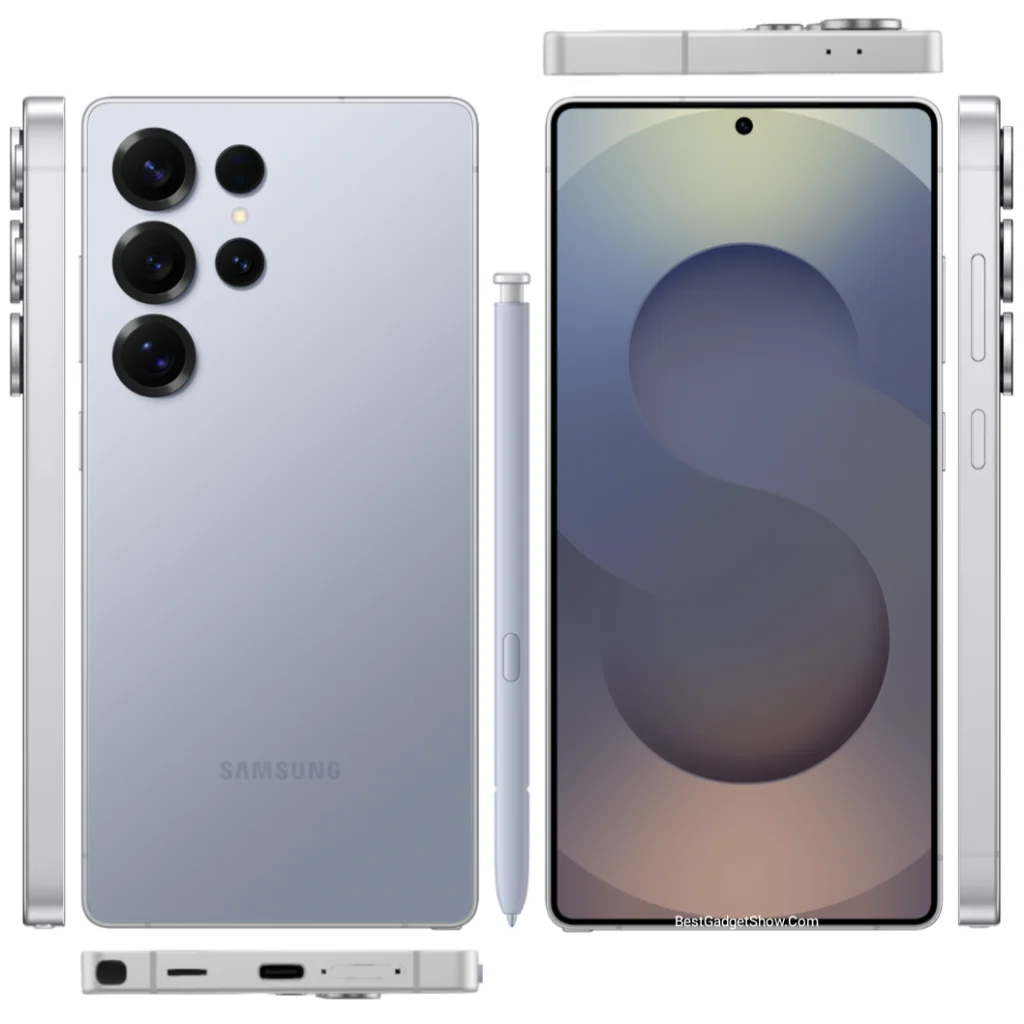
1. Elegant and Durable Design
The Galaxy S25 Ultra showcases a refined design that balances elegance with durability. Featuring a sleek, symmetrical aluminum frame and a curved glass construction, the device looks premium while maximizing comfort in hand. The front and back are protected by the latest Gorilla Glass Victus 3, offering resistance to scratches and impacts. With IP68 certification, the phone withstands dust and water exposure—making it reliable in all environments.
Color Options
Choose from sophisticated hues such as Phantom Black, Mystic Silver, and Sapphire Blue—each finished with a subtle matte texture that resists fingerprints and enhances grip.
2. Next‑Level Display Performance
Samsung’s leadership in display technology shines through the Galaxy S25 Ultra’s immersive screen.
- 6.9‑inch Dynamic AMOLED 2X display
- 4K resolution (3840 × 2160) for razor‑sharp text and visuals
- Adaptive 120 Hz refresh rate, adjusting from 1 Hz to 120 Hz based on content
- Peak brightness hitting 2,600 nits, ensuring visibility even under direct sunlight
- True 10-bit color and HDR10+ support for vivid contrast and lifelike tones
Whether scrolling, gaming, editing videos, or binge‑watching, the stunning display enhances every interaction—making movies cinematic and text razor-sharp.
3. Power and Speed: The Processor and Memory
Under the hood, the Galaxy S25 Ultra is powered by the latest Snapdragon 8 Gen 4 Mobile Platform (in most markets), built on a cutting‑edge 3 nm process. This chip delivers breakthrough CPU and GPU performance for intensive tasks such as 3D gaming, video editing, and AI multitasking.
- CPU: 1×3.3 GHz prime + 3×3.1 GHz performance + 4×2.3 GHz efficiency cores
- GPU: Adreno 750 with advanced ray‑tracing support
- RAM: Up to 16 GB LPDDR5X
- Storage: 256 GB, 512 GB, or 1 TB UFS 4.0
Expect lightning‑fast app launch times, seamless multitasking, and future‑proofed storage. The 16 GB model is ideal for power users running multiple pro‑grade apps simultaneously.
4. Unmatched Camera System
Photography and video capture on the Galaxy S25 Ultra represent a major leap forward.
Rear Camera Array
- 200 MP wide-angle sensor with OIS and super‑resolution binning – captures exceptional detail, even in low light
- 50 MP telephoto lens, 5× optical zoom – ideal for crisp mid-range shots
- 10 MP periscope telephoto lens, 10× optical zoom – perfect for distant subjects without clarity loss
- 12 MP ultra-wide sensor – captures landscape and group photos with ease
Notable Camera Features
- 200× space zoom using hybrid zoom and AI sharpening
- 8K/60 fps video recording, 10‑bit depth, HDR10+ grading
- Super‑steady 2.0 stabilization for shake‑free video
- Director’s View and Expert RAW for creative control
- Nightography Pro: combines multiple exposures with AI for superior low‑light images
Front‑Facing Camera
The 40 MP selfie camera delivers enhanced skin tone detail and sharpness. It supports HDR10+ video capture and 4K/60 fps recording, making it perfect for vlogging and video calls.
5. Battery Life That Keeps Up
The Galaxy S25 Ultra is equipped with a 5,500 mAh battery, offering robust endurance for a full day of mixed use and beyond.
- 45W wired charging: Reaches 65% in about 20 minutes
- 15W wireless charging using Qi2 specification
- 4.5W reverse wireless sharing for powering earbuds or accessories
With intelligent battery management and adaptive refresh rate, users consistently see all‑day uptime—even under heavy tasks like gaming or streaming.
6. Connectivity and Features
Connectivity options are state‑of‑the‑art:
- 5G (mmWave + sub‑6 GHz) for ultra‑fast downloads and smooth streaming
- Wi‑Fi 7 and Bluetooth 5.4 ensure low latency and fast file transfers
- Ultra Wideband (UWB) support for enhanced location tracking and device interoperability
- NFC, STP, and eSIM compatibility
Biometrics & Security
Secure access is handled by an audio‑based ultrasonic fingerprint sensor that’s larger, more accurate, and more secure than previous models. Face unlock leverages the high-resolution front camera complemented by intelligent depth detection for enhanced reliability.
7. Software – Intuitive, Efficient, and Customizable
The Galaxy S25 Ultra runs One UI 8 atop Android 15, offering a smoothed‑out user experience with future‑ready features:
- AI‑driven Quick Panel: suggests actions like replying to frequent contacts or launching key apps
- Seamless DeX support: mirror your phone to a monitor wirelessly
- App Continuity: keep apps open across devices
- Samsung Knox Vault: hardware‑backed secure storage for passwords and encryption keys
Samsung guarantees five years of Android upgrades plus an extra year of security patches—ensuring longevity and peace of mind.
8. Audio and Multimedia Experience
The Galaxy S25 Ultra delivers immersive audio for media and communication:
- Dual stereo speakers tuned by AKG, with Dolby Atmos surround sound
- 34-bit Quad DAC (where available) enhances headphone quality with high-resolution audio
- Virtual 3D audio effects select modes for movies, music, gaming
Even without headphones, the audio feels rich and immersive—with clear mids, robust bass, and balanced treble.
9. Sustainability and Eco‑friendly Approach
Samsung’s commitment to sustainability is clear in the S25 Ultra:
- Recycled aluminum frame and Ocean‑Bound plastic in packaging and accessories
- Samsung’s eco packaging is minimalist, reusable, and printed with soy ink
- Includes a plant‑based phone case that is both durable and biodegradable
These efforts reduce carbon footprint and promote responsibility from production to end‑of‑life recycling.
10. Comparison With Previous Models
| Feature | S24 Ultra | S25 Ultra |
|---|---|---|
| Main Camera | 108 MP | 200 MP |
| Display Resolution | QHD+ (3,088 x 1,440) | 4K (3,840 x 2,160) |
| Processor | Snapdragon 8 Gen 3 | Snapdragon 8 Gen 4 |
| Battery | 5,000 mAh | 5,500 mAh |
| Charging | 45W wired | 45W wired + 15W wireless |
| OS Upgrades | 4 years | 5 years |
These highlights show that while the S24 Ultra was already outstanding, the S25 Ultra pushes boundaries further in critical areas like camera, display clarity, processing power, and battery capacity.
11. Ideal Use Cases
The Galaxy S25 Ultra meets the needs of a wide range of users:
- Mobile content creators benefit from professional-grade camera tools and editing software
- Professionals gain from powerful multitasking, DeX support, and long software support cycle
- Gaming enthusiasts enjoy ultra‑smooth graphics, fast refresh rate, and powerful cooling
- Business users rely on biometric security and seamless cross‑device continuity
In essence, the S25 Ultra is the go‑to device for anyone wanting top‑tier technology without compromise.
12. Accessories and Ecosystem Integration
Samsung enhances the S25 Ultra experience through its ecosystem:
- S Pen Pro with Bluetooth support and gyro sensing—use it for drawing, signing, or remote shooting
- Galaxy Buds 3 Pro offering active noise cancellation and immersive sound
- Wireless PowerShare allows you to charge earphones, watches, or other Qi-compatible devices
- Smart home integration via SmartThings—control lights, speakers, and appliances from your phone
Final Thoughts
The Samsung Galaxy S25 Ultra stands as the ultimate flagship handset—merging cutting‑edge hardware, versatile cameras, long‑summer software support, and premium design. It’s tailored for users who demand peak performance in photography, productivity, entertainment, and sustainability. If you’re looking for a device that will remain high‑end years from now and serve as a creative or professional hub, the S25 Ultra sets a new benchmark.
Image
OFFICIAL IMAGE
Samsung Galaxy S25 Ultra Titanium Silver Blue
Samsung Galaxy S25 Ultra Titanium Black
Samsung Galaxy S25 Ultra Titanium Gray
Samsung Galaxy S25 Ultra Titanium White Silver
Samsung Galaxy S25 Ultra Titanium Jade Green
Samsung Galaxy S25 Ultra Titanium Jet Black
Samsung Galaxy S25 Ultra Titanium Pink Gold
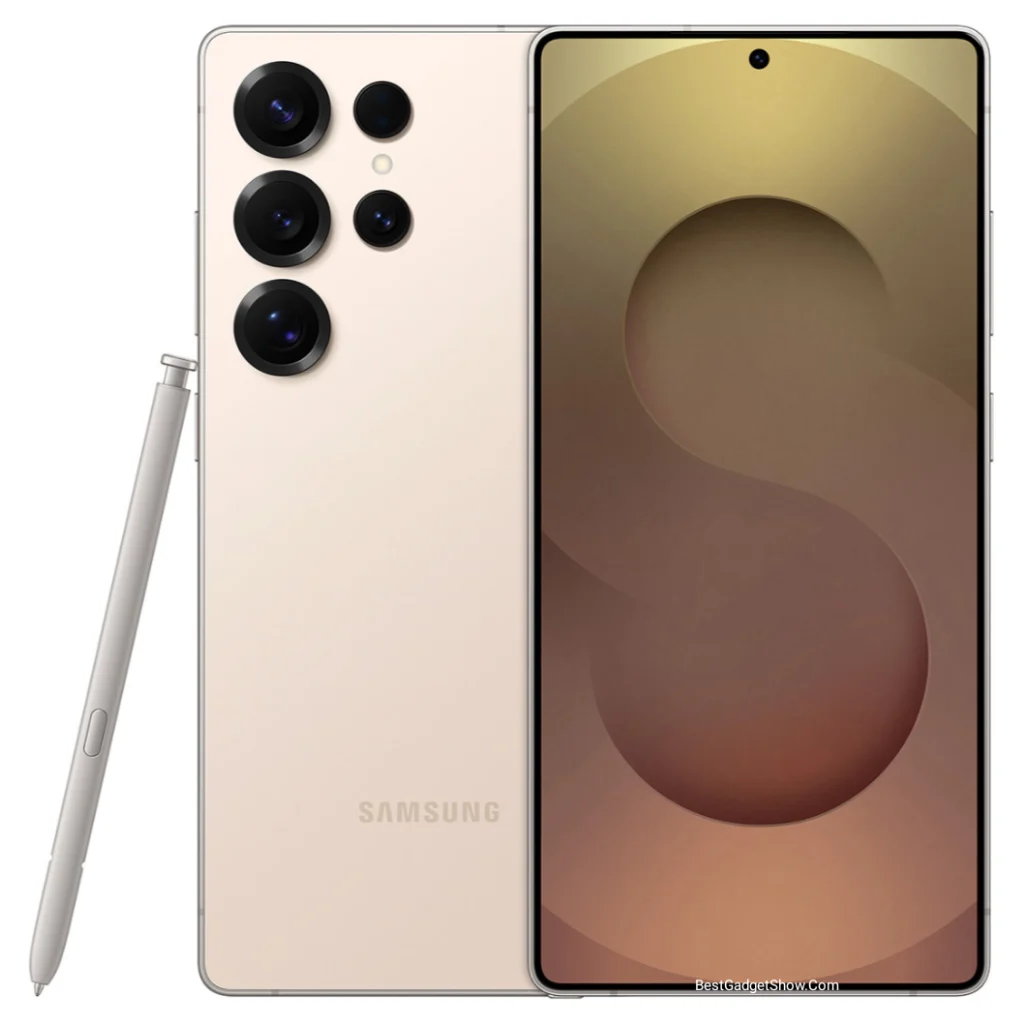
Reviews
Disclaimer Note
While we strive to provide accurate and up-to-date information, we do not guarantee the 100% accuracy or completeness of the content on this website.
